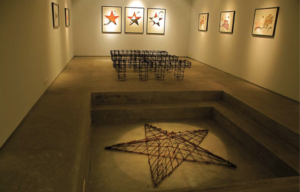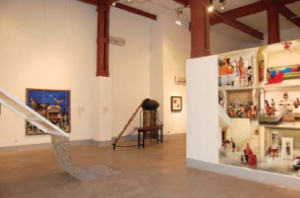After the languid and not very stimulating monsoon months, the Calcutta art scene is abuzz once again. A few good solo exhibitions and an excellent ‘Gen Next IV’ have done much to provide the viewing public with some unexpected treats. Quite a few of the works at ‘Gen Next IV’ organized by the Aakriti Art Gallery from October 1st to 31st, explored intriguing themes of escapism, vulnerability and artificiality versus authenticity. On the whole, the sculptural arrangements and digital works were of a higher standard than the paintings (Atul Mahajan, NantuBehari Das and ParthaGuin being the best examples) but some paintings like those of SagarBhowmick were no less impressive and were, in fact, penetrating explorations of vulnerability as both tangible and a mirage.

Ramakrishna Behera’s exhibition at Bose Pacia between September 10th and October 16th was impressive both in its form and its content. It depicted a unique narrative text: one that investigated time through an image-oriented medium. His self-explanatory Cup of Coffee – out of which flowed the universe – presented different forms of temporality in a manner which was both visually and intellectually stimulating. The past, memory and recollection came together through the use of strong narrative and stylistic devices like the banana tree and overcame the complexities of resolving these problems within the pictorial surface. The tension between the certainty of the past within the realms of the memory and its fragmentation within each moment of the present was especially well explored through the temporal fluidity of the past bursting through the image and projecting the ‘present’ contained within it.
‘In Memory of an Ideal’, Ng. BidyutSingha’s show at Experimenter from September 14th to October 31st was a scathing indictment of socialism and its effects on a hapless populace. It looked at socialism from a region-specific standpoint creating an imaginary village Irabot Nagar (named after the Manipuri poet, HijamIrabot Singh) with an unfinished memorial at its centre (which made excellent use of the gallery’s somewhat irksome central cavity). This poignant installation which depicted a large but incomplete – and, in a sense, decaying star in metal and a series of metallic supports showed how monument building and political commemoration were invidious tools of propaganda in socialist regimes as well as a metaphor for the unfulfilled promises of socialism as a whole. The accompanying drawings (fire, dry pastel and charcoal on paper) which were sensitive and subtle – a deliberate counterpoint to the bulk of the memorial – showed a gradually disappearing star, symbolic of the human cost of the socialist experience. The watercolour ‘portraits’, on the other hand, which used devices such as boats and bridges to represent the lives of those who lived under a regime which had fundamentally failed them conveyed an overwhelming sense of political repression. Thus, Singha critiqued both the ideology and the aesthetics of socialism using a visual language which was powerful yet elegant (as the set of thirty small works displayed as a grid which showed vignettes of the memorial being constructed with highly effectual drops of red paint demonstrated) and had all the refinement of imagery and metaphor that is expected of a conceptually strong and technically proficient show.
The exhibition at Gallery K2 from October 7th to October 30th helped reexamine the paths and processes of the late Shaibal Ghosh’s subsequent body of work through these hitherto unexhibited small format black and white works and drawings which were powerful, yet at ease with themselves, lyrical, tragic, beautiful, and profound. Three significant tendencies were brought together in these works: the formal or structural element underlying Ghosh’s art; the lived and experienced dimension; and the deep and often melancholic sensibility. The juxtaposition of form and structuring with the existential provided the key to unlocking this unique sensibility. All the works dated from the early to mid 1970s and showed that even as a young artist, Ghosh had reoriented within his own work some of the aesthetic experiential possibilities of what he saw and felt around him. These were exquisite mindscapes: rich in content, allegories and symbols. Ghosh’s virtuosity was apparent in his strong sense of narrative, dynamic compositions, rich tonality, depth of feeling and hints of abstraction all of which combined to produce a rare and almost hallucinatory look and feel that was almost graphical in nature.

Two large, stimulating group shows at the Birla Academy and Bose Pacia respectively also succeeded in delighting local audiences. ‘Astonishment of Being’, curated by DeekshaNath at the Birla Academy was a delightful smorgasbord of works. Cogent, coherent, conceptually strong and very well displayed, it managed to bring together a wide variety of practices and visual vocabularies while maintaining a sense of unity. RanbirKaleka’s video projection Not From Here was the most stimulating work of the exhibition. A sensitive, touching and poignant depiction of working class hopes, desires and aspirations, it combined strong aesthetic values with a genuine sense of understanding and empathy. ‘Re-Claim/Re-Cite/Re-Cycle’, curated by Bhavna Kakar and presented by Latitude 28 & Seven Arts Ltd. at Bose Pacia, looked at the various facets of recycled and appropriated imagery. Responding to the daily barrage of imagery, the participating artists sought to create a new order by extracting images (Manjunath Kamath and Prajjwal Choudhury in particular) and notions (ChittrovanuMazumdar) from their original contexts and reinterpreting and reassembling them, thereby infusing their works with a new meaning. Parody, criticism and social commentary were the dominant themes of this show which looked at both the process and substance of image making and cultural memory as well as our aesthetic heritage.
With the much anticipated opening of the Harrington Arts’ Centre and the Seagull Arts and Media Resources Centre making part of its space available to young artists twice a month to showcase their talent, there is a buzz about the Calcutta art scene at the moment. The city’s galleries also appear to have toned down their obsession with showing the moderns and are beginning to exhibit more exciting, contemporary works and are simultaneously looking to get involved with new media practices. All of these should contribute towards making the next few months thrilling for the aficionado of contemporary art in Calcutta.













